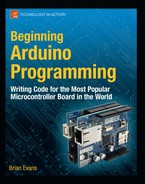Summary
In this chapter we had a good look at a few different forms of serial communications, from the hardware serial port on the Arduino microcontroller; to the software emulation of serial on any of the general purpose I/O pins; and I2C, a serial communication protocol for talking to various sensors, displays, and other devices. This was only the tip of the iceberg because there are even more communication protocols, like Serial Peripheral Interface, or SPI, and OneWire among others. Hopefully, though, this chapter has shown some of the similarities and a few of the differences between these few protocols to make learning new ones easier than before.
Speaking of learning new things, in the next chapter we are going to continue on with a loose collection of ideas for new projects, new hardware, and new programming languages. We'll even show a few ways that you might contribute back to the open hardware community by sharing what you've learned. With a solid framework for programming the Arduino firmly established, we will open up our discussion to include many of the things that we haven't yet been able to cover in depth. We'll show you some neat things and how they might be put to use, hopefully to inspire even greater projects than previously imagined. No more lengthy sketches and source code summaries, instead we will provide a brief overview of some of the many directions you might want to take with your newfound Arduino knowledge, and leave the rest in your capable hands.
